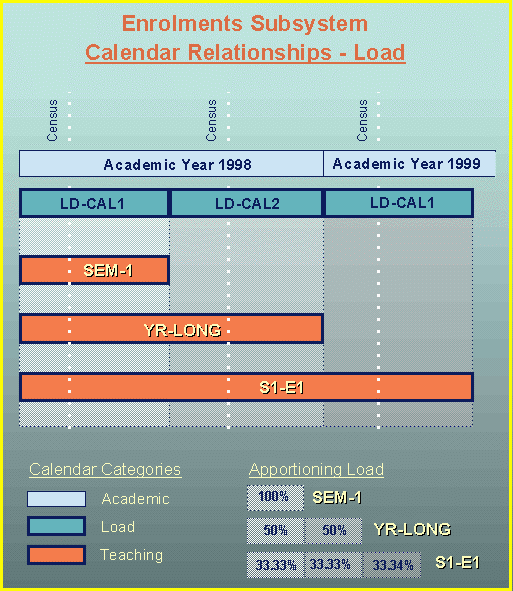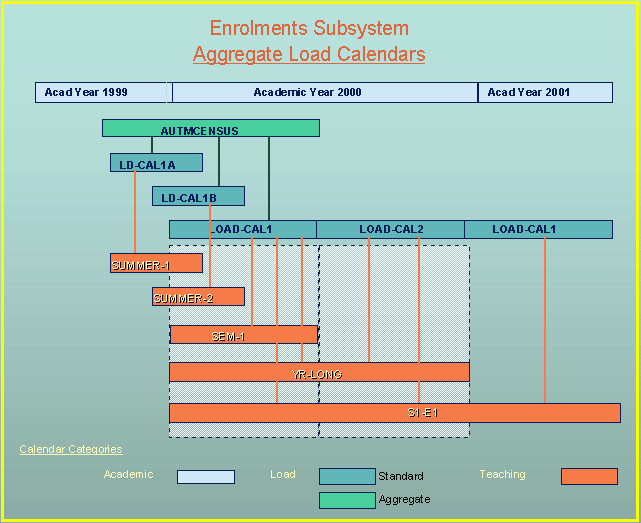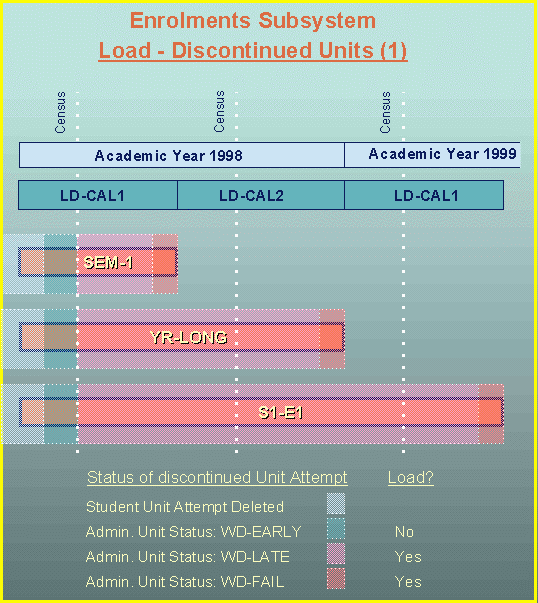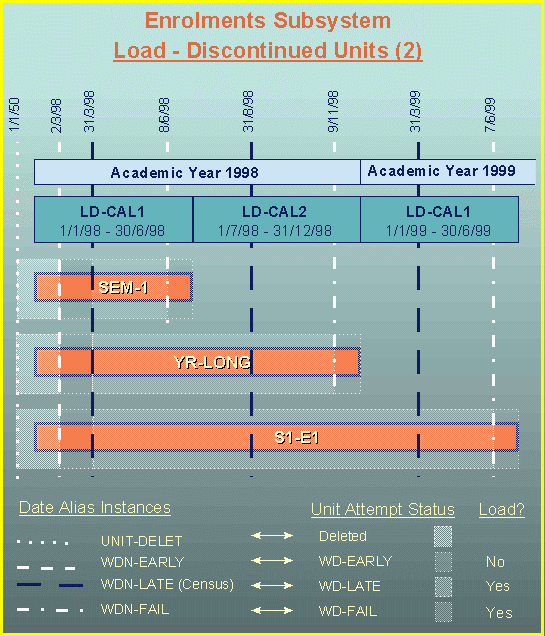This section describes:
NOTE: Many of the procedures described here are likely to be performed only by a specialist user.
A number of calendar categories exist in the System. One of these categories is LOAD. The calendars in this category specify the periods of time against which student load is calculated. They are used in:
A load calendar belongs (in a parent/child relationship) to one academic calendar only, and normally each load calendar spans only one government census date. Conversely, teaching calendars (and therefore study units) may span one or more load calendars.
The diagram below outlines a typical configuration of academic, load and teaching calendars. It is the basis for the explanations which follow. Of course, institutions will set up these relationships to reflect the pattern of their own teaching periods. Moreover, different configurations can be made available concurrently to cater for a variety of teaching delivery patterns which might run at the same time (for example, award courses and courses offered for commercial clients).

This diagram assumes three teaching calendars, all starting at the same time, but running for:
This is a simplified view, for in reality teaching calendars of the same length will probably start at various points in the academic year. To extrapolate from the example, teaching periods named SEM-2, YR-LONG-2, and S2-E2 might all start mid-year in 1998, while another instance of S1-E1 starting in semester 1 1999 will be beginning as the instance shown in the diagram ends (they will overlap during one semester). Additionally, the start and end of teaching periods need not dovetail exactly with the start and/or end of a load calendar instance.
Aggregate load calendars are calendars whose specific purpose is to group together two or more standard load calendars so that load can be considered for the combined calendars rather than for each individual calendar.
This allows standard load calendars to be created to measure student load in non-traditional teaching periods. Standard load calendars linked to an aggregate load calendar are still used for purposes such as fee assessment within a corresponding fee period, determination of load contribution of discontinued unit attempts and government statistical reporting. Standard load calendars not linked to aggregate calendars may be used for all load calculation purposes.
Aggregate load calendars can be used to group two or more standard load calendars for purposes such as:

This diagram illustrates how an aggregate load calendar (AUTMCENSUS) can be used to group a number of standard load calendars (LD-CAL1A, LD-CAL1B, LOAD-CAL1) to provide an aggregated view of load. Using the aggregate load calendar, attendance type, for example, can be determined at the autumn census date (31 March). Load under all three standard load calendars is summed and the total compared to the attendance type load ranges for AUTMCENSUS.
Aggregate load calendars are discussed further in Load Calendars - Special Topic.
Student load is always calculated for a single load period (a load calendar instance) whenever required (this may be an aggregate load period). This means that a student's load as at a particular date within an instance can be anticipated or determined at any time both during and after the instance. Load predictions can be calculated for future load periods as soon as the calendar structures are in place and students have enrolled.
Study units represent a certain number of credit points or EFTSU towards a student's load, as specified in the Maintain Basic Unit Details form (CRSF2210) in the Course Structure and Planning subsystem. But for units with teaching periods which span more than one load period, the load which the unit represents must be split across two or more load periods. This is so for the YR-LONG and S1-E1 examples above. Here, load is distributed evenly between two load periods for YR-LONG, and between three for S1-E1.
However, load for a teaching period can also be distributed unevenly across the span of two academic calendars (but not more than two). In our example, this means that for YR-LONG, load could be split between LD-CAL1 and LD-CAL2 in proportions such as 60%-40%, 20%-80% or any other ratio totalling 100%. Similarly, for S1-E1, load could be split across LD-CAL1 (98), LD-CAL2 (98) and LD-CAL1 (99) in any desired proportion, for example 50%-30%-20%. The distribution of teaching calendar load between load periods is recorded in the form Maintain Load Calendar Structure (ENRF01K0).
This load apportionment holds good for all enrolled and completed student unit attempts. For students who have discontinued a unit attempt, the System must decide whether or not they should incur load in a particular load period. This is described below.
Note: Load apportionment is not recorded for aggregate load calendars. They 'collect' load from their subordinate standard load calendars.
This explanation relies on an understanding of the discontinuation mechanism explained in Managing Unit Discontinuation, and follows through the example given there.
For simplicity, this mechanism was demonstrated using one teaching period, SEM-1. But because the administrative unit statuses shown there also carry implications for load, we now need to consider them in relation to teaching periods of different lengths. The diagram below reflects this more complex scenario.
enr10

Once again this diagram assumes a simple data structure where one set of administrative unit statuses is used in three different teaching calendars. If required, different sets could be applied to different teaching calendars.
Recall that when a student discontinues a unit attempt, the System finds the most recent discontinuation date alias instance in that teaching calendar before the student's discontinuation date. These discontinuation date aliases are matched to administrative unit statuses except where the unit attempt is deleted (typically a very early withdrawal). The table below summarises this matching for the data used in our example.
|
Date Alias |
Administrative Unit Status |
|
UNIT-DELET |
|
|
WDN-EARLY |
WD-EARLY |
|
WDN-LATE |
WD-LATE |
|
WDN-FAIL |
WD-FAIL |
Setting up the mechanism to handle load for discontinued student unit attempts involves:
The final diagram below brings together the strands discussed and demonstrated in the previous diagrams.
enr11

Once the load mechanism is set up, this is the logic used to calculate whether a discontinued unit attempt contributes to a student's load in any load period:
Where load is incurred, it is added in the proportion already specified as this teaching period's contribution to the particular load period.
|
Example scenarios - determining load |
|
These scenarios apply the logic above, and are based on the previous diagram. They use an equal apportioning of load across load calendars, as shown in the Calendar Relationships - Load diagram. For LD-CAL1, 1998
For LD-CAL2, 1998
For LD-CAL1, 1999
|
There is a direct relationship between the load incurred by a student and their attendance type. Students enrol in a course offering option which is of a particular attendance type. They then enrol in units, each of which attracts a specified amount of load. The System calculates the load for a student in two ways for two distinct purposes.
1. To report an attendance type, for each student, to government.
This attendance type is determined by comparing the student's calculated load (for a particular reporting period, load is calculated for all of a student's course attempts across all relevant teaching periods using the relevant apportionment factors) to the load ranges defining attendance types for the academic period.
2. To determine the attendance type of a course for a particular academic period:
for comparison with the student's enrolled course attempt attendance type (for checking against 'forced' course attempt attributes) . The System makes validation checks to see whether the total load for all load incurring units in which the student enrolled is within the acceptable load range for the attendance type of the course attempt. The units considered are those in teaching periods linked to load calendars which are subordinate to the student's course enrolment period.
3. To determine the attendance type of a course for a particular load period:
for display of a derived attendance type in various Callista forms and for attendance type related administrative purposes, such as internal fees and charges and library borrowing privileges.
This attendance type is determined by comparing the student's calculated load for a course attempt to the load ranges defining attendance type for a particular load calendar period.
|
Example |
|
A student has enrolled in a full-time course. The acceptable load range for full-time enrolment in this course is 0.750 - 2.000 EFTSU. The student elects to study units with a total load of 0.750 EFTSU in this academic period (this year). This student is reported to government as a full-time student. The same student may be enrolled in units totaling 0.250 EFTSU in semester 1 and 0.500 EFTSU in semester 2. The acceptable load range for full-time enrolment in each of two load calendars corresponding to these semesters is 0.375 - 1.000 while the part-time load range is 0.001 - 0.374. The institution uses attendance type (full or part-time) to determine a service fee. The student's load for first semester is within the part-time load range so the student is liable for the part-time service fee rate in semester 1. The student's load for second semester is within the full-time load range so the student is liable for the full-time service fee rate in semester 2. |
Further information:
Last modified on 12 November 1999